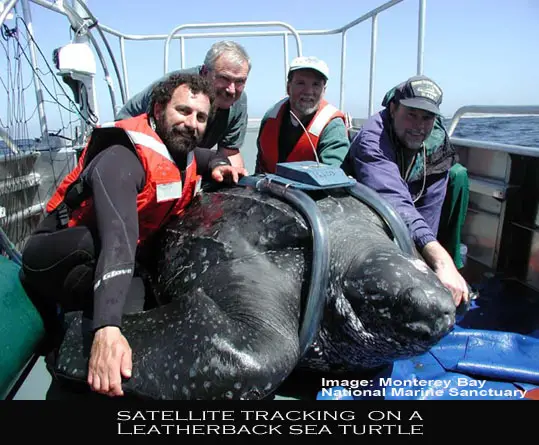Kingdom: Animalia
Phylum: Chordata
Class: Reptilia
Order: Testudines
Family: Dermochelyidae
Genus: Dermochelys
Species: coriacea
Leatherbacks Dermochelys coriacea are the oldest, largest, and widest-ranging marine animals ever to swim through our global ocean. The leatherback is the only sea turtle that lacks a hard, bony shell. A leatherback’s carapace is approximately 4 cm (1.5 inches) thick and consists of leathery, oil saturated connective tissue overlaying loosely interlocking bones. They can grow up to 2.7 metres (9 feet), 1.8 metres (6 feet) wide, whilst weighing almost a ton they can dive as deep 800 metres (half a mile). They are the Earth’s most endangered sea turtle and are declining rapidly in the Pacific Ocean.
Larry Crowder of Duke University is quoted as saying, “They survived over 100 million years, through climate change and asteroid impacts, but they could become extinct in the next 10-20 years unless sufficient international cooperation is mounted to reverse this dramatic decline. There are probably fewer than 1500 females nesting throughout the Pacific Rim.”

In terms of climate change and sea turtles, and as the atmospheric temperature increases, so will that of the sand surrounding the eggs. Due to the incubation temperature determining the sex of sea turtle hatchlings, the more the beach temperatures rises, a greater number of females will be produced. Studies have also shown that too much exposure to temperatures over 34°C (93°F) can be lethal to some turtle embryos.
The idea of environmental sex determination is in contrast to most of the animals we are familiar with. Generally we think of animals having genetic sex determination in which the sex of the offspring is determined by the genetic contribution of the father. For instance, offspring receiving an X chromosome from the father develop into female embryos, and offspring receiving a Y chromosome from the father develop into male embryos. The sex ratios of human babies tend to be 1:1, because the probability of receiving either chromosome is equal at conception. This might appear a bit strange to humans, but it is not uncommon in the animal world. For instance, the sex of alligators and crocodiles are similarly affected by incubation temperature (although males are produced at warm temperatures).
Some scientists are now suggesting that global climate change has the potential to eliminate the production of male turtle offspring if mean global temperatures increase 4°C, (7.2°F) and increases of less than 2°C (3.6°F) may dramatically skew the male-female sex ratios.
Turtles appear a good environmental indicator for the impacts of global climate change. You might consider the scenario of climate change and sea turtle extinctions a bit far-fetched, but other scientists believe that the disappearance of dinosaurs may be linked to environmental sex determination and rapid climate change.
|
Other Species Impacted Upon by Climate Change
Quiver Tree |
